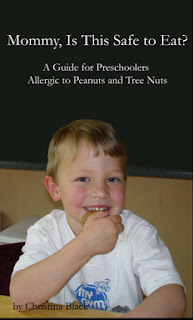(post by Mrs. NoPeanuts)
I recently came across a research study that claimed a diet rich in fish and fruity vegetables such as tomatoes or eggplant, can cut asthma and allergy incidence in children. As a biologist, I find the scientific side of my daughter’s allergy intriguing and the research (or lack thereof) always interesting to read.
Researchers from the Department of Social Medicine at the University of Crete, Greece, and writing in the journal Pediatric Allergy and Immunology, studied the diet of 460 Spanish children.
They discovered that children who consumed more than 40 grams of "fruity vegetables" a day - namely tomatoes, eggplant, cucumber, and green beans - were much less likely to suffer from childhood asthma. In addition they found that children who consumed more than 60 grams of fish with a high omega-3 content also suffered less childhood allergies.
The study adds to a body of evidence supporting the health benefits of omega-3 and a diet high in vegetables.
What is interesting to note is that my daughter and I ourselves participated in a research study for Omega-3 conducted at our Children’s Hospital. The purpose of our study of course was not to examine foods linked to allergies but to help determine whether a dietary supplement of docosahexaenoic acid (DHA) during pregnancy has any effect on pregnancy duration or early infant development.
At 17 weeks pregnant, I started to take a supplement (which could have been omega-3 or I may have been in the control group) and continued throughout my pregnancy. The supplement stopped when I delivered.
For the first 18 months of my daughter’s life, the researchers monitored weight, height, head circumference and we ‘played’ games that observed eyesight, speech perception, problem solving, behaviour, motor skills and cognitive understanding.
Interestingly enough, when I became pregnant with our second daughter, we enrolled once again in the study and by complete chance we were put in the same study group, meaning whatever supplement I received with my first daughter I also received with my second.
And low and behold…my first daughter suffered from extreme eczema during her infancy and now also lives with anaphylaxis to peanuts and eggs. My second daughter, who received similar Omega-3 exposure in the womb (as I didn’t change my diet – except for the removal of peanuts and eggs), has no eczema and to date, thank goodness, no allergies.
“This is not the first time a diet rich in "fruity vegetables" has been linked to having the potential to reduce the risk of respiratory conditions like asthma, chronic bronchitic symptoms, and wheeze. However, this study claims to be unique because it assessed maternal dietary habits during pregnancy as well as children's dietary habits.”
“Fruits and vegetables are rich sources of antioxidant vitamins such as vitamins C, E and carotenoids, and other antioxidants such as selenium and flavonoids, that are thought to reduce airway inflammation by protecting airway cells from endogenous and exogenous oxidative damage,” the researchers said.
However, they found that no other fruits or vegetables were significantly associated with wheeze or allergy prevalence. The lead researcher, Dr Chatzi commented: "The biological mechanisms that underlie the protective affect of these foods is not fully understood, but we believe that the fruity vegetables and fish reduce the inflammation associated with asthma and allergies."
Though I do not know for sure, there is reason to believe that I did indeed have the Omega-3 supplement during my pregnancy for our first daughter, vs the placebo. There were no actual numbers provided in the Spanish allergy study but it does sound like our daughter’s Omega-3 consumption would make her an exception to the rule.
Despite all of the current research efforts, we still do not clearly understand what causes food allergy. There is an apparent randomness as to allergy incidence and severity.
